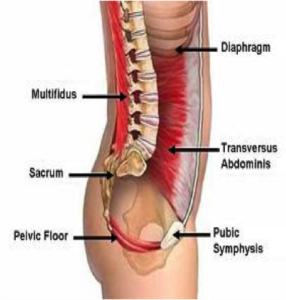Are you Stable or ?
August 09, 2017

What is Stability?
Clinical stability can be defined as the spines ability under load to limit patterns of displacement in order not to damage or irritate the spinal cord and nerve roots, and to prevent deformity or pain caused by structural changes. Spinal stability is the basic requirement for the transfer of movement between the upper and lower extremities used for tasks of daily living, exercise and sports. Studies show that without any forms of ‘stability’ the human spine collapses easily.
How Does it Work?
Stability is provided in a coordinated manner by the active (e.g. muscles), passive (e.g. lumbar spine/ ligaments) and control (e.g. neurological) systems. The deep core muscular system is a 3 dimensional space comprised of:
Transversus Abdominus
- Acts to compresses the abdominal cavity, by doing so it acts as a lumbar stabiliser in that it doesn’t actually move the trunk, but rather supports and stabilises each individual vertebrae.
- Assists in breathing.
Multifidus
- This muscle lies in between either side of the spinous processes of the spinal vertebrae, and runs along the entire length of the spine.
- The multifidus provides stiffness, stability, and support to the spinal column.
Pelvic Floor
- Forms the floor of the deep core, aids in supporting pelvic organs ( e.g. bladder, intestines).
- Assists with continence control.
- Helps to maintain optimal intra-abdominal pressure.
Diaphragm
- Forms the roof if the deep core.
- Helps control intra-abdominal pressure for optimal stabilisation support of the lumbar spine.

Why is it so important?
The inherent nature of these muscular boundaries is to produce a corset like stabilisation effect on the trunk and spine. This is important in the prevention of early biomechanical deterioration of the spine components (e.g. arthritis) and reduction of energy expenditure during muscle activity.
More over substantial evidence exists demonstrating that people with lower back pain have insufficient activation and weakening of transversus abdominus and multifidus than those without lower back pain.
Here at Nelson Bay Physiotherapy and Sports Injury Centre we believe that stability is an integral part in injury rehabilitation and prevention. As part of our services we run tailored Pilates programs to target your individual needs. For more information please ask our friendly reception staff, click here ‘Clinical Pilates’ or read our previous post ‘Personalised Pilates Men too’.
Written by: Nicole Pereira
References:
Eunyoung, K., & Hanyong, L. (2013). The effects of deep abdominal muscle strengthening exercises on respiratory function and lumbar stability. Journal of Physical Therapy Science, 25(6), 663-665.
Chang, W.D., Lin, H.Y., & Lai, P.T. (2015). Core strength training for patients with chronic low back pain. Journal of Physical Therapy Science, 27(3), 619-622.
Izzo, R., Guarnieri, G., Guglielmi, G., &Muto, M. (2012). Biomechanics of the spine. Part 1: spinal stability. European Journal of Radiology, 82(1), 118-126.
Ramos, L.A., Franca, F,J., Callegari, B., Burke, T.N., Magalhaes, M.O. & Marques, A.P. (2015). Are lumbar multifidus fatigue and transversus abdominus activation similar in patients with lumbar disc herniation and healthy controls? A case control study. European Spine Journal, 25 (5), 1435-1442.
Southwell, D.J.; Hills, N.F.; Mclean, L. & Graham, R.B. (2016). The acute effects of targeted abdominal muscle activation training on spine stability and neuromuscular control. Journal of NeuroEngineering and Rehabilitation, 13(1), 19.
